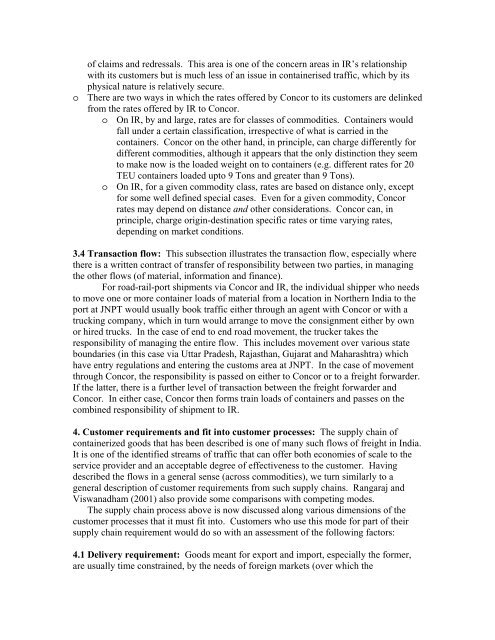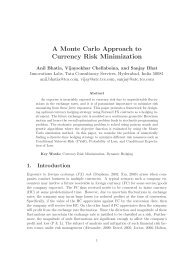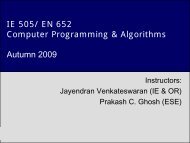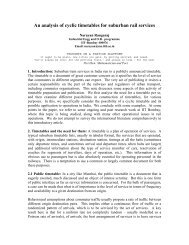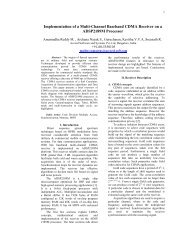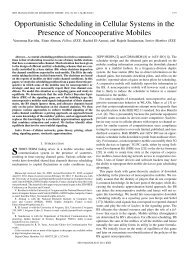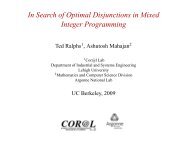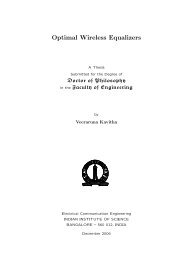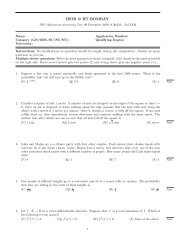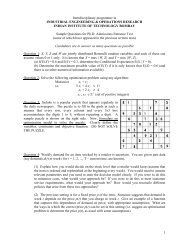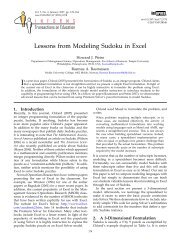PDF Link - Industrial Engineering and Operations Research (IEOR)
PDF Link - Industrial Engineering and Operations Research (IEOR)
PDF Link - Industrial Engineering and Operations Research (IEOR)
- No tags were found...
Create successful ePaper yourself
Turn your PDF publications into a flip-book with our unique Google optimized e-Paper software.
of claims <strong>and</strong> redressals. This area is one of the concern areas in IR’s relationshipwith its customers but is much less of an issue in containerised traffic, which by itsphysical nature is relatively secure.o There are two ways in which the rates offered by Concor to its customers are delinkedfrom the rates offered by IR to Concor.o On IR, by <strong>and</strong> large, rates are for classes of commodities. Containers wouldfall under a certain classification, irrespective of what is carried in thecontainers. Concor on the other h<strong>and</strong>, in principle, can charge differently fordifferent commodities, although it appears that the only distinction they seemto make now is the loaded weight on to containers (e.g. different rates for 20TEU containers loaded upto 9 Tons <strong>and</strong> greater than 9 Tons).o On IR, for a given commodity class, rates are based on distance only, exceptfor some well defined special cases. Even for a given commodity, Concorrates may depend on distance <strong>and</strong> other considerations. Concor can, inprinciple, charge origin-destination specific rates or time varying rates,depending on market conditions.3.4 Transaction flow: This subsection illustrates the transaction flow, especially wherethere is a written contract of transfer of responsibility between two parties, in managingthe other flows (of material, information <strong>and</strong> finance).For road-rail-port shipments via Concor <strong>and</strong> IR, the individual shipper who needsto move one or more container loads of material from a location in Northern India to theport at JNPT would usually book traffic either through an agent with Concor or with atrucking company, which in turn would arrange to move the consignment either by ownor hired trucks. In the case of end to end road movement, the trucker takes theresponsibility of managing the entire flow. This includes movement over various stateboundaries (in this case via Uttar Pradesh, Rajasthan, Gujarat <strong>and</strong> Maharashtra) whichhave entry regulations <strong>and</strong> entering the customs area at JNPT. In the case of movementthrough Concor, the responsibility is passed on either to Concor or to a freight forwarder.If the latter, there is a further level of transaction between the freight forwarder <strong>and</strong>Concor. In either case, Concor then forms train loads of containers <strong>and</strong> passes on thecombined responsibility of shipment to IR.4. Customer requirements <strong>and</strong> fit into customer processes: The supply chain ofcontainerized goods that has been described is one of many such flows of freight in India.It is one of the identified streams of traffic that can offer both economies of scale to theservice provider <strong>and</strong> an acceptable degree of effectiveness to the customer. Havingdescribed the flows in a general sense (across commodities), we turn similarly to ageneral description of customer requirements from such supply chains. Rangaraj <strong>and</strong>Viswanadham (2001) also provide some comparisons with competing modes.The supply chain process above is now discussed along various dimensions of thecustomer processes that it must fit into. Customers who use this mode for part of theirsupply chain requirement would do so with an assessment of the following factors:4.1 Delivery requirement: Goods meant for export <strong>and</strong> import, especially the former,are usually time constrained, by the needs of foreign markets (over which the


